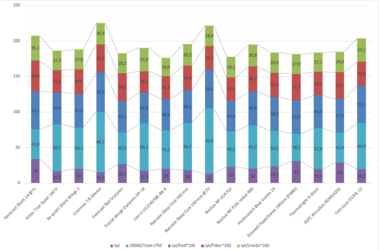-
Welcome to Overclockers Forums! Join us to reply in threads, receive reduced ads, and to customize your site experience!
You are using an out of date browser. It may not display this or other websites correctly.
You should upgrade or use an alternative browser.
You should upgrade or use an alternative browser.
FRONTPAGE 15 Case Fans Tested: Ultimate 140 mm Roundup
- Thread starter Overclockers.com
- Start date
- Joined
- Nov 28, 2001
In most cases, you can plug the 3 pin fans directly in a 4 pin header...and control them with voltage.
If you are looking for quiet fans that move a lot of air, check out the fans in my dig. The Noctuas I have listed there are MUCH quieter than the Noctua iPPPC PWM are...these get noisy at 1500+ rpm
I'm not 100% sure that is how my mobo works. There are 4 pin and 3 pin connectors on the board, and there is no option to switch between PWM or Voltage control for the 4 pin connectors. From my understanding, it will only control the RPM automatically for 3 pin fans on the 3 pin connectors, not the 4 pin. I'll have to test it to be sure, but I would also like to populate all the fan spots I can, which is more then what the motherboard has headers for. So either way, I need some kind of splitter, that will control the extra couple of fans, and PWM seems to be the easiest way to tie in all the radiator fans to the CPU header, and leave the rest of the headers for the case fans.
magellan
Member
- Joined
- Jul 20, 2002
I was looking at the 140's as case fans. I threw in the 140mm rad when I realized it was 16FPI. They made the rad for 800rpm quiet rad fans. I was mainly looking at how well these fans will pull against a dust filter. The sparse rad simulates a heatsink.
If I ever get a real 30FPI 140mm rad, you can bet I'll test those Noctuas. But pushing on a rad is much easier to test than pulling. You can permanently attach the rad to your mixing box and swap fans. This is easy. Pulling through a rad requires you to fasten the fan directly to the mixing box, then attach the rad to the fan -- think fan sandwich here. Doable, but a pain. And you probably end up with a destroyed box.
I suppose you could use the current rig but reverse the airflow -- just measure the air you pull into the box. For some reason, I'm a little leery about that. But i'll think about it if I ever get a "real" 140mm rad.
I've seen that San Ace. I've lusted after that San Ace. But the cheapest I could find it was $59 US -- a little steep for a fan I would test but never use.
If I can ever get some more 140mm case fans together -- think Corsair, Deepcool, Phanteks, Thermaltake, etc. -- I'd certainly do another roundup. Now that I have a testing system together, I'm curious.
Interesting article ehume, wouldn't SanAce and others be willing to provide you w/fans for your articles?
- Joined
- Oct 30, 2009
San Ace sells fans for industrial use. They distribute fans through premiere/Farnel/Newark to engineers and others building test equipment. So far, I have not seen them interested in mere enthusiasts like us.
Promo a $50 fan? I don't think so. But if our editors can get them to send me a couple, I'd be glad to review them. As for the 120mm fans, I have specimens of their silent series from L to H. I have 8 PWM M's. And the there are their 120x38mm beasts. You could call me a San Ace fan -- pun intended. Actually, I have included the 120x25mm fans in a review, here and here. But send out fans for review? I'll believe it when I see it.
Promo a $50 fan? I don't think so. But if our editors can get them to send me a couple, I'd be glad to review them. As for the 120mm fans, I have specimens of their silent series from L to H. I have 8 PWM M's. And the there are their 120x38mm beasts. You could call me a San Ace fan -- pun intended. Actually, I have included the 120x25mm fans in a review, here and here. But send out fans for review? I'll believe it when I see it.
magellan
Member
- Joined
- Jul 20, 2002
San Ace sells fans for industrial use. They distribute fans through premiere/Farnel/Newark to engineers and others building test equipment. So far, I have not seen them interested in mere enthusiasts like us.
Promo a $50 fan? I don't think so. But if our editors can get them to send me a couple, I'd be glad to review them. As for the 120mm fans, I have specimens of their silent series from L to H. I have 8 PWM M's. And the there are their 120x38mm beasts. You could call me a San Ace fan -- pun intended. Actually, I have included the 120x25mm fans in a review, here and here. But send out fans for review? I'll believe it when I see it.
LOL. My 1st SanAce fan was one of their 120mm x 38mm models. I got it for free -- out of some old lab equipment. It's really quiet -- at least relative to all my other fans. I really like the 140mmx38mm as well, it's also quiet.
Are the 140mmx38mm SanAce fans expensive because SanAce doesn't manufacture many of them? Or maybe because they don't distribute them outside of the Asian world?
You can get them here easily: http://www.amazon.com/Sanyo-Denki-SAN-Ace-120mm/dp/B00QWB1X3O
- Joined
- Oct 30, 2009
The 140x38mm fans are expensive because they would cost twice as much to build as the $18 9G1212H101, but they do not make near as many, so their costs are higher. They make an industrial quality frame, an industrial quality impeller a strong motor ans strong ball bearings.
BTW -- the link is to a 12cm fan.
BTW -- the link is to a 12cm fan.
The point was that San Ace fans can be found in the US. 
But since you are a stickler for the details : http://www.performance-pcs.com/san-ace-109p1412m101-ultimate-140mm-high-speed-case-fan-sleeved.html
: http://www.performance-pcs.com/san-ace-109p1412m101-ultimate-140mm-high-speed-case-fan-sleeved.html
But since you are a stickler for the details
But my wife put me on a buy-no-more-fans diet . . .
Same here, after years of fan hoarding, with 3 (ex crt monitor boxes
- Joined
- Sep 13, 2015
Speaking of San Ace fans I have been thinking of picking up this pack of them off of Amazon. I just don't know if I want to run a second power supply just for the fans .
.
http://www.amazon.com/Sanyo-Denki-S...F8&qid=1455075071&sr=1-2&keywords=san+ace+fan
http://www.amazon.com/Sanyo-Denki-S...F8&qid=1455075071&sr=1-2&keywords=san+ace+fan
- Joined
- Oct 30, 2009
Speaking of San Ace fans I have been thinking of picking up this pack of them off of Amazon. I just don't know if I want to run a second power supply just for the fans.
http://www.amazon.com/Sanyo-Denki-S...F8&qid=1455075071&sr=1-2&keywords=san+ace+fan
Be aware that a normal 9G1212H101 San Ace is 40dB and draws less than 0.5A. Your224 CFM monsters will be screamers.
Had to LOL at this.
Question: RPM and Decibal ratings?
Answer: 224 cfm 6400rpm 64db
By Jose F. on January 15, 2016
- Joined
- Sep 13, 2015
WHAT????
CAN'T HEAR YOU!!!
DID YOU SAY SOMETHING???
I figure it will be a good excuse for when I don't hear my wife
 .
.I also figured it would be fun to mount 18 of them on a radiator just for giggles. And at a cost of only $5 a piece it is a hard price point to beat. I can always slow them down to help make them quieter.
- Joined
- Oct 30, 2009
I wouldn't be too sure of that. More likely you'd have 18 fans you can't use. You'd be better off saving your money.. . . I can always slow them down to help make them quieter.
For $5 each you can get 2500 rpm San Aces @40 dB. Much more tolerable.
For anyone interested I've created the chart with data from the article. The lower is the dot - the better is the fan
https://1drv.ms/x/s!AhIwJHZ40ocwoqFn_wPGlWkbgwt9RA
Btw it would be great if articles included some kind of raw data used in them
https://1drv.ms/x/s!AhIwJHZ40ocwoqFn_wPGlWkbgwt9RA
Btw it would be great if articles included some kind of raw data used in them
Similar threads
- Replies
- 11
- Views
- 4K
- Replies
- 4
- Views
- 944
- Replies
- 0
- Views
- 837


